
THE
EDGE
800-662-9278 | Michigan.gov/EGLEInlandLakes
Helping sh and
wildlife on your
lakeshore property
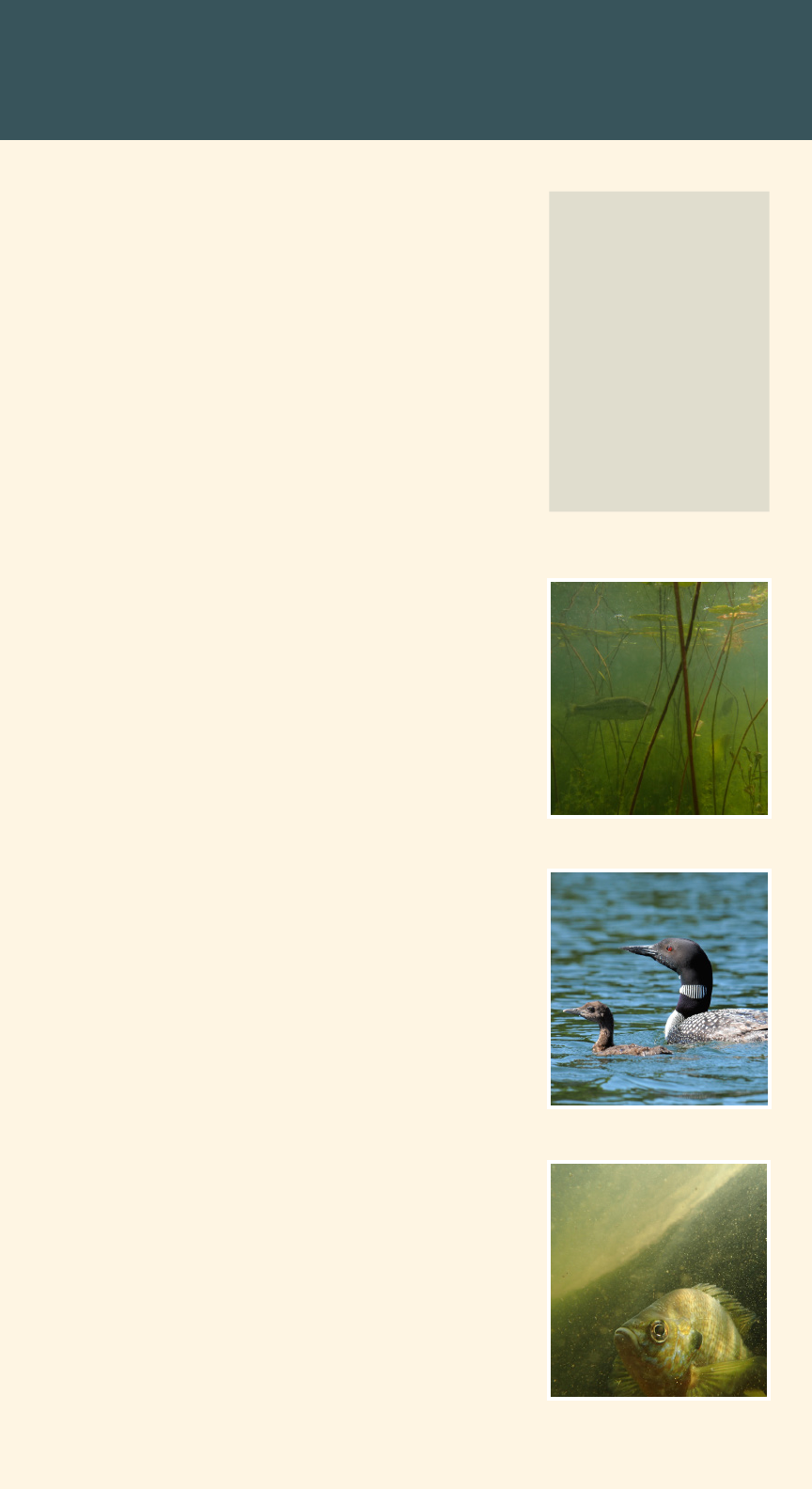
T
he water’s edge is a busy place. Northern
pike, bluegills, bass, and other sh spawn in
the shallow water along the shore. Loons, ducks,
sandhill cranes, and other water birds nest along
the banks. Wildlife such as frogs, otters, and mink
live there too. Shoreline areas—on land and into
the shallow water—provide essential habitat for sh
and wildlife that live in or near Michigan’s lakes.
Overdeveloped shorelines can’t support the sh,
wildlife, and clean water that are so appealing to
the people attracted to the water’s edge.
Unfortunately, that’s exactly what’s happening
to many Michigan lakes. The problem is poorly
planned lakeshore development. Bit by bit,
the cumulative effects of tens of thousands of
lakeshore homeowners “xing up” their property is
destroying one of the state’s valuable resources—
its fragile lake habitats. Some examples:
Sand trucked in for swimming beaches covers
underwater gravel or silt used by:
• sh for spawning
• mayies for burrows
• frogs for laying eggs
Aquatic vegetation removed to create swimming
and boating areas eliminates shoreline-
stabilizing plants that are also habitat for:
• bass and other sh that hide among the plants
and spawn in areas protected from waves
• loons that nest on oating vegetation
• waterfowl that feed on underwater plants
• insects that live among underwater vegetation
Shoreline shrubs and “unsightly” fallen trees are
removed to create golf course-type lawns, thus
eliminating habitat for wildlife such as:
• songbirds that use these shrubs for nesting
• ducks that lay eggs in native shoreline grasses
• turtles that sun on fallen logs
• bass and pansh that hide in the shade
under toppled trees.
“Protecting and
restoring shoreline
habitat is critical
to the health of an
entire lake. If you
want great shing,
you must protect your
natural shorelines.”
Jim Dexter,
DNR Fisheries
Eric Calabro
Eric Calabro
Roger Darden
Shoreline habitat
2

O
wners of shoreland property often bring with them traditional
landscaping ideas that strive for the conventional, suburban “clean” look
of a golf course or a beach. Yet, besides eliminating sh and wildlife habitat,
this type of landscaping also creates problems for homeowners such as:
• Green water: A mowed lawn sends rain runoff carrying fertilizers, pet
waste, and the lawn clippings to the water where they fuel algae blooms
that make swimming less enjoyable.
• More erosion: Water plants such as bulrushes, cattails, and coontail
soften the erosive effects of waves along shores. Removing these plants
increases erosion.
• Nuisance wildlife problems: Traditional lawns attract geese, which are
grazers. In one week, an adult goose can produce 15 pounds of slippery,
smelly droppings.
The combined effect of shoreline alterations by many property owners on a
lake destroys habitat and causes declines in sh and wildlife populations. It’s
ironic that many lakeshore property owners buy their lots because they enjoy
nature and then unknowingly harm habitat by altering the natural landscape.
Most species of sh and wildlife don’t thrive along sandy swimming beaches
or on mowed lawns. They do best within the tangles of aquatic (“weeds”) and
shoreline cover (“brush”) that lakeshore owners frequently remove.
Landscaping that’s
unfriendly to sh and wildlife
Chris Frieburger
“Clean” lawns can make dirty lakes
3
Rain that would
seep into the
soil ows more
quickly off
rocks and lawns
straight into the
lake. The runoff
carries pet
waste, fertilizer,
and other lake
pollutants.
All natural vegetation along
the water’s edge has been
eliminated—and with it has
gone the shrubs and grasses
needed by birds, butteries,
and other wildlife.
With all the aquatic vegetation gone,
sh have no place to live. Waves
will stir up sediment and destroy
spawning areas.
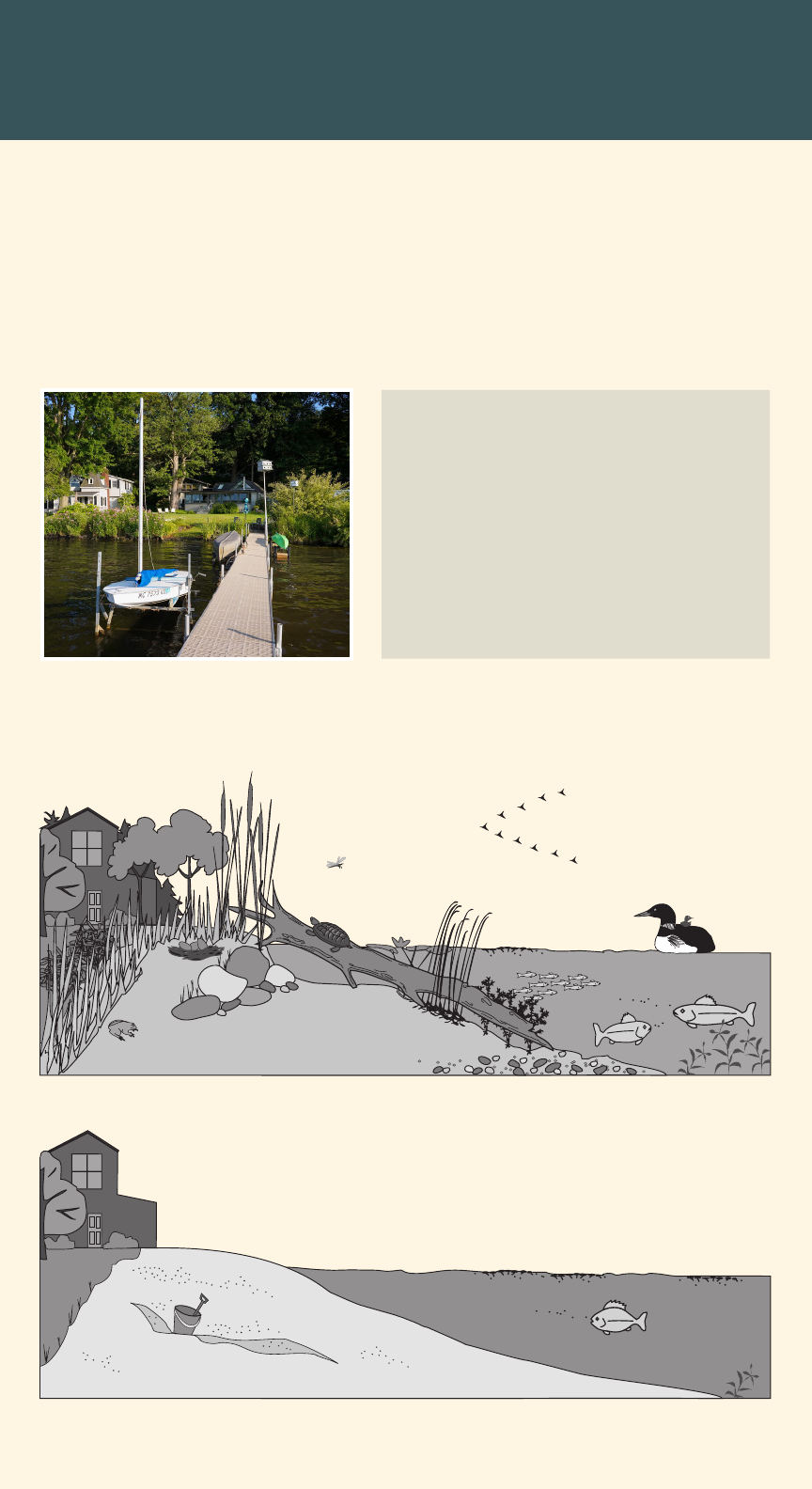
4
S
horeline habitat consists of many natural elements woven into the lake
ecosystem to form a web of life. Native vegetation, bottom materials, and
natural debris play essential roles in the life cycles of a lake’s sh and wildlife.
Nearshore alterations that damage or destroy these habitat components sever
essential strands in the web. As a result, the lake ecosystem is weakened,
wildlife and sh numbers decline.
The value of shoreline habitat
What can you do?
A growing number of lakeshore owners
are switching from traditional mowed
lawns to native grasses and wildowers.
In addition to helping wildlife, native
plants require little to no maintenance.
That frees up more of your time to go
shing, watch wildlife, and otherwise
enjoy being at the lake.
Mark Bugnaski Photography
Amy B. Beyer
Amy B. Beyer
4
Lightly developed shoreline = lots of sh and wildlife
Overdeveloped shoreline = few sh and wildlife

5
Shoreline buffers
Kathleen Preece
5
N
earshore vegetation provides habitat for
many wildlife species. Waterfowl nest in
shoreline grasses, while songbirds build their nests
in trees and shrubs. Natural shorelines are wildlife
highways, or travel corridors, for animals such as
mink. Grasshoppers, ants, and other insects that
live in shoreline vegetation are blown into the lake,
where they are eaten by bluegills and other sh.
A tidy lawn and a sandy beach make great spots
for sunbathing and swimming, but they provide
little habitat for sh and wildlife. By leaving a
buffer of natural vegetation along the shoreline,
property owners can reduce erosion, help
maintain water quality, and provide habitat and
travel corridors for wildlife.
The width of the buffer strip depends upon the
terrain. On a gentle slope, having a 35 to 50 foot
strip of natural vegetation between the water’s
edge and the lawn will accommodate the needs of
many shoreline wildlife. On steeper grades, leaving
even more natural vegetation in place will stabilize
soils and reduce the need for retaining walls or
other erosion prevention. Trees and shrubs in the
buffer strip can mufe noise from watercraft while
providing nesting areas for songbirds.
Avoid using pesticides or fertilizers in the buffer
strip because harmful chemicals can leach into
the lake. Pesticides kill benecial insects living in
shoreline vegetation that are important foods for
sh, birds, and other wildlife.
Have your lawn—
and wildlife too
You don’t need to give
up a lawn and beach
to create a natural,
wildlife-friendly
lakeshore.
If you have 100
feet of shoreline,
consider reverting
75 feet back to its
natural condition
and keeping 25 feet
for a boat dock and
swimming area.
Additionally, if you
restore the area near
the lake to natural
grasses and shrubs,
you can still keep
plenty of lawn up near
the house or cabin
while helping ducks,
songbirds, butteries,
and other wildlife.
Along your shoreline, try
to maintain a buffer of native
grasses, wildowers, shrubs, and
trees. Native plants especially
good for wildlife are sugar
maples, bur oaks, cranberries,
dogwoods, native grasses, and
wildowers. Benecial aquatic
plants include bulrushes, wild
rice, arrowhead, cattails,
and bur reeds.

6
Woody cover
B
ecause most Michigan lakes are surrounded
by trees and shrubs, storms and winds often
blow dead or dying branches, limbs, and trees
into the water. This woody debris is important to
lake ecosystems. Beneath the water’s surface,
woody material is critical habitat for tiny aquatic
organisms that feed bluegills, turtles, craysh,
and other critters. Water insects such as mayies
graze on the algae that grows on decomposing
wood. Dragony nymphs hunt for prey among the
stems and branches. Bass nd food, shelter, and
nesting sites among fallen trees.
Above water, a fallen tree is like a dock for wildlife.
Ducks and turtles rest and sun themselves on
the trunk. Predators such as mink and otter hunt
for prey in the vicinity of the tree. Dead trees that
remain along the shoreline are used as perches by
belted kingshers, ospreys, and songbirds.
Many lakeshore owners consider this woody debris
unsightly and remove it from their shoreline. Yet
this takes away hiding and feeding areas for many
sh and wildlife species. Unless the fallen tree is a
hazard to navigation or swimming, consider leaving
it in the water to improve sh and wildlife habitat,
shing, and wildlife observation.
What can you do?
Leave fallen trees in
the water to provide
habitat for sh and
wildlife.
Eric Calabro
Waterfowl, turtles,
and other wildlife
use fallen trees as
resting sites.
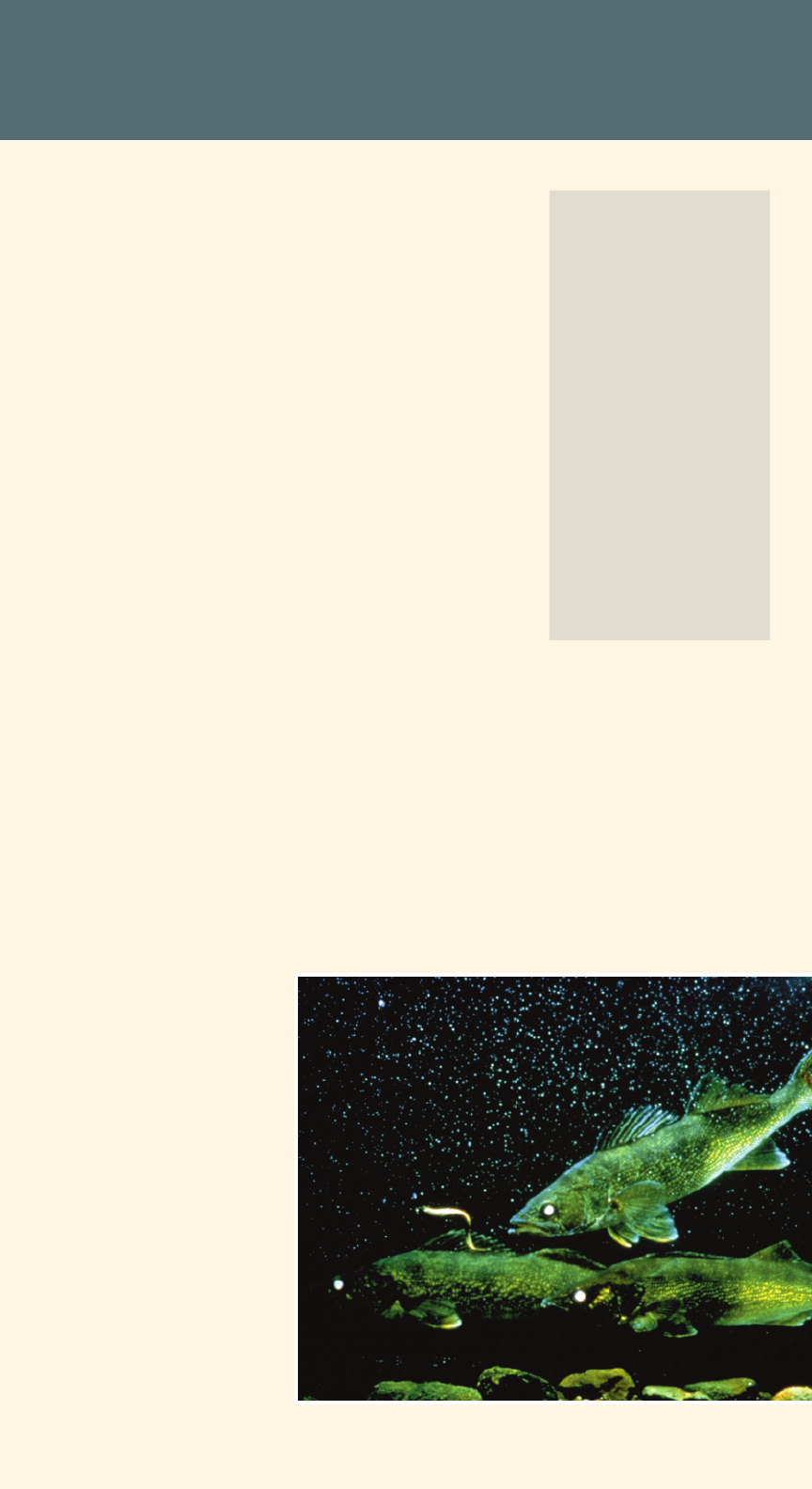
7
Bottom materials
L
ocal geography and geology determine what
natural materials exist on lake bottoms and
shorelines. Hard lake bottoms and beaches
made up of sand or gravel are usually in open
areas exposed to waves. Soft bottoms composed
of muck are usually in shallow, sheltered bays.
Areas with lots of rocks and boulders were left by
receding glaciers 10,000 years ago.
Bottom material, called substrate, is used by sh
and other aquatic life. Walleyes spawn on the clean
gravel of wave-swept shorelines. Mucky bottoms
support insects and other invertebrates that provide
food for sh and wildlife. Craysh, smallmouth bass,
and other species hide and forage among rocks.
Pure sand is the least ecologically productive lake
bottom substrate. Yet lakeshore dwellers frequently
buy property and then alter the shore and bottom by
dumping sand to improve a swimming area. Creating
sand beaches on soft bottoms is expensive and
covering rock-rubble bottoms with sand destroys sh
spawning areas, and reduces sh populations.
Before creating a large beach, lakeshore owners
should know that their shoreline alteration will
eliminate sh and wildlife habitat from the entire lake
ecosystem, and may require permits from EGLE.
What can you do?
• Minimize the size
of your sandy
beach to allow
for more natural
shoreland and
underwater
vegetation.
• If buying property,
look for shoreline
and lake bottom
that match your
desires. Don’t
expect to change
it into something
it isn’t.
In-Fisherman
Rock and gravel
bottoms are important
spawning areas for
game sh such as
walleyes and forage
species such as
suckers, darters, and
some minnows.

Emergent Plants
Floating-leaf Plants
Submergent Plants
Algae
8
Aquatic vegetation
O
ften dismissed as “weeds” by many
lakeshore property owners, aquatic plants
provide essential sh and wildlife habitat and
help keep lakes clean and healthy. Through
photosynthesis, aquatic vegetation produces
oxygen for the lake. Wetland vegetation provides
food and cover for waterfowl and other wildlife.
Removing aquatic vegetation to improve boating
or swimming eliminates sh habitat and damages
the root network that holds bottom sediments in
place. For example, bulrushes keep silt carried by
waves from covering bottom gravel used by bass
and pansh for spawning. When bulrush beds are
removed, waves also begin to erode the shoreline.
Wave action and boat wakes also stir up sediment,
causing the lake water to become murky. If
sunlight cannot penetrate the cloudy water, many
healthy and vibrant lakes can eventually turn into
a green soup, devoid of most desirable sh and
wildlife species.
What can you do?
• Leave aquatic
plants along the
shoreline.
• Consider re-
establishing
aquatic plants
along the
lakeshore.
• Utilize docks &
swim platforms
rather than
removing
vegetation for
access.
David Howell
Shoreline vegetation
provides critical habitat for
benecial insects, such as this
mosquito‑eating dragony.
Biologists refer to aquatic plants as emergent,
submergent, and oating‑leaf vegetation.
Emergent vegetation protrudes above the water’s
surface; submergent vegetation stays underwater;
and oating‑leaf plants rest on the water surface.
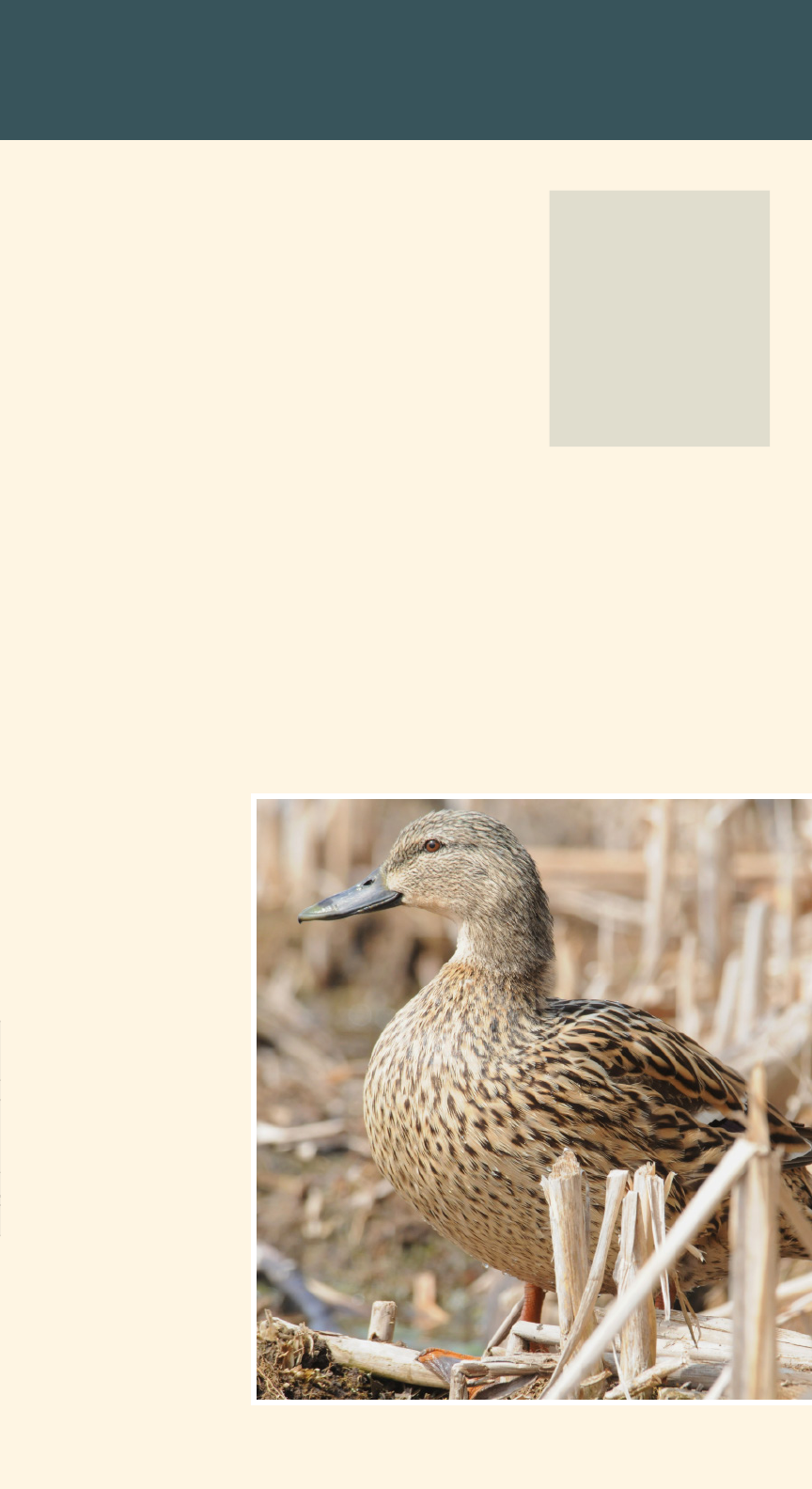
Emergent Plants
Floating-leaf Plants
Submergent Plants
Algae
9
Wetlands
W
etlands help keep lakes clean by ltering
sediments and excess nutrients. Acting like
natural sponges, wetlands slow down water. This
function reduces ooding, stabilizes lake levels,
and provides recharge for groundwater.
Shoreline wetlands are habitat for a diverse
community of plants and animals such as
northern pike, which spawn among aquatic
vegetation. Nutrient-rich sediments and soils
in wetlands support insects, frogs, and other
small animals eaten by sh and wildlife. Wetland
vegetation provides food and cover for waterfowl,
muskrats, and other wildlife.
Marshes, bogs, bulrush beds, and other shoreline
wetlands have been disrupted by lakeshore
property owners to create boat docks and
swimming beaches. The loss of a lake’s wetland
areas leads to poorer water quality, lower game
sh populations, and ooding.
What can you do?
• Don’t ll or alter
wetlands, even if
they are only wet
in the spring.
• Consider
restoring drained
or lled wetlands.
Amy Peterson
Healthy wetlands
attract nesting and
migrating waterfowl.
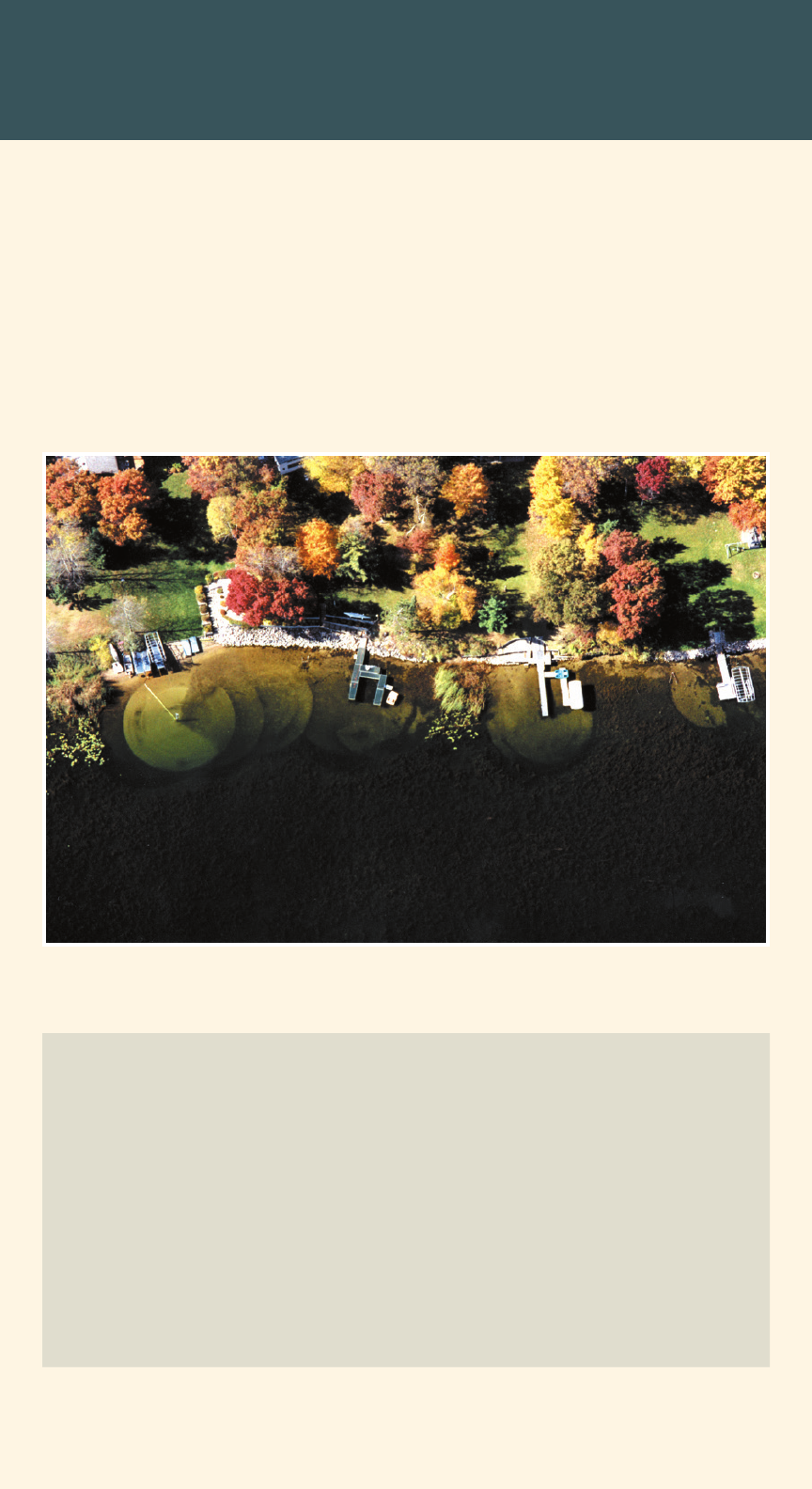
10
I
t’s up to everyone who values lakes to keep them healthy and productive.
Many lakeshore owners wonder what difference alterations to their one
lake lot could possibly make. But when the actions of dozens or hundreds
of individual property owners are added up, the sum effect can alter the
habitat and water quality on that lake. The cumulative harm from shoreline
alterations by many lakeshore property owners affects swimming, shing,
wildlife watching, and the overall health of the lake. It’s like walking in a
garden. If a neighbor kid came through once, that would be no big deal but
if the whole neighborhood came through, the garden would be trampled.
We’re all responsible
Dick Stoltman
This picture shows the cumulative impacts of vegetation elimination on
the nearshore habitat of an inland lake. When multiplied around the lake,
individual shoreline alterations affect the overall health of Michigan Lakes.
Protecting watersheds
A watershed is a basin that collects water from the surrounding
landscape. A healthy lake depends on a healthy watershed. Logging,
farming, livestock grazing, and urban development occurring in a
watershed can affect a lake’s water quality. Pollutants and eroding soil
within the entire watershed can easily end up in the lake. Poor land use,
even several miles away, can end up harming sh and wildlife habitat in
a lake. Some lake associations map the lake’s watershed to inventory
and evaluate activities taking place. When activities that degrade water
quality are discovered, people living in the watershed work together to
nd a solution.
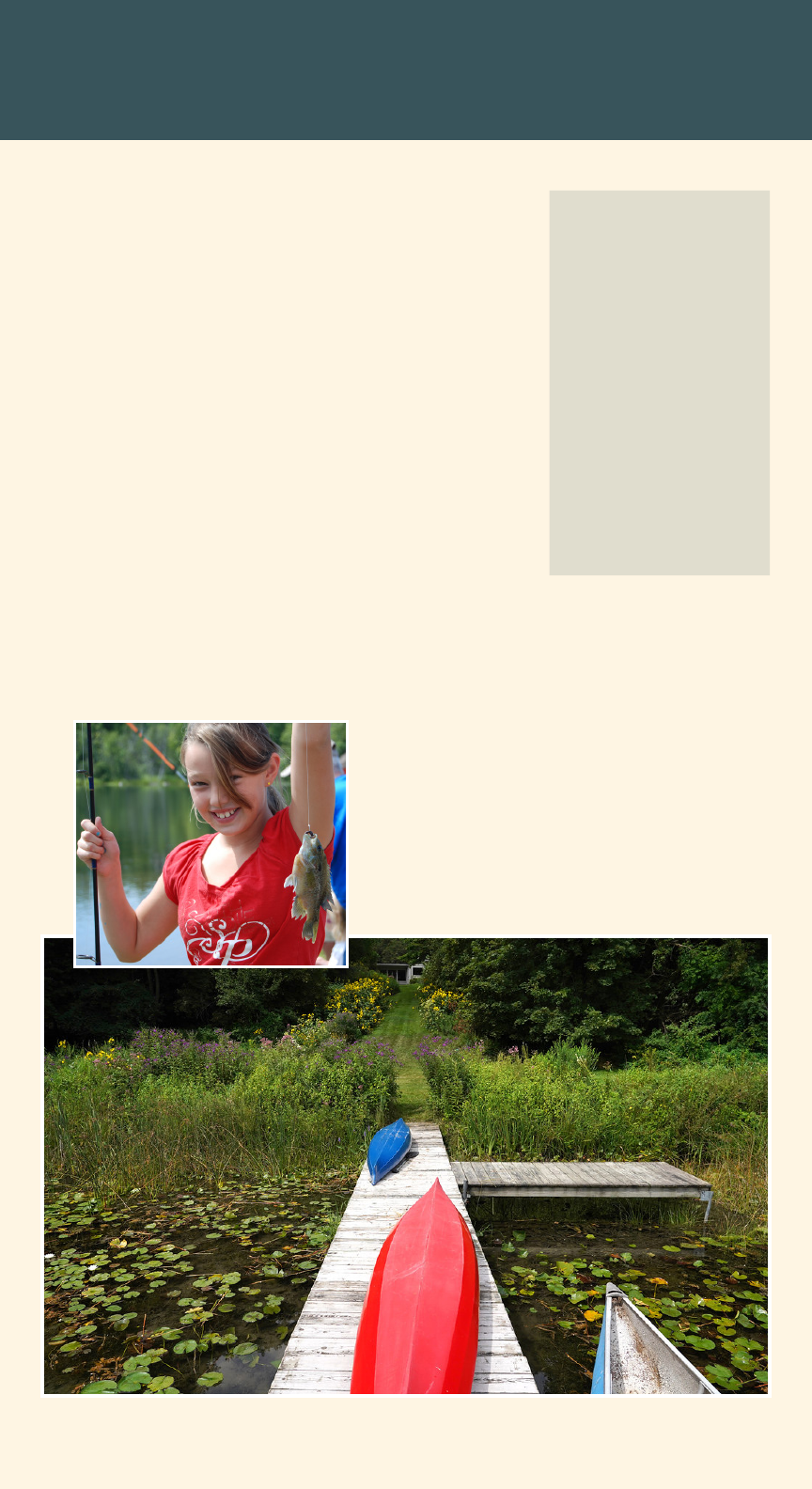
11
Prescription for a healthy lake
A
healthy lake is a functioning ecosystem.
The water is safe for swimming and shing.
The aquatic habitat supplies food, cover, and
spawning areas for sh. Natural shoreline
vegetation supports sh, songbirds, small
mammals, and other wildlife. Throughout this
lake’s watershed, land management activities are
planned to improve water quality.
A healthy lake doesn’t just happen. It comes
about when shoreline property owners and others
living in the watershed take steps to ensure the
lake’s ecological health. Only if more lakeshore
owners manage their shoreline in a natural
condition can sh and wildlife populations on
Michigan lakes stay healthy and abundant.
More things to know
Several state laws
and rules protect
shorelines, wetlands,
and oodplains. For
example, it is illegal
to construct seawalls
and beaches wihout
a permit.To learn
which shoreline
alterations are
prohibited without
a permit, call your
local EGLE ofce.
Good shing doesn’t just
happen. It’s the result of clean
water and abundant spawning
habitat found in lakes that still
have plenty of natural shoreline.
Mark Bugnaski Photography

For more information
The Michigan Department of Environmental Quality (EGLE) is responsible for the
protection of the natural resources and public trust of inland lakes. You can get
information on permits and laws from EGLE through their Environmental Assistance
Center (800-662-9278), on the web (
Michigan.gov/EGLEInlandLakes
) or by
contacting your local EGLE ofce. EGLE staff are happy to discuss your project so
that it meets both personal and environmental concerns.
The Michigan Natural Shoreline Partnership (MNSP) is an organization made up
of experts from EGLE, universities, resource conservation groups, and industry
designed to assist lakefront property owners who wish to restore natural shoreline
habitat along their waterfront. The MNSP educates contractors and landscape
professionals on natural shoreline methods, and provides workshops for
landowners. Visit
MiShorelinePartnership.org
for more information.
MICHIGAN
NATURAL
SHORELINE
PARTNERSHIP
12/2022
The Michigan Department of Environment, Great Lakes, and Energy does not discriminate on
the basis of race, sex, religion, age, national origin, color, marital status, disability, political
beliefs, height, weight, genetic information, or sexual orientation in the administration of
any of its programs or activities, and prohibits intimidation and retaliation, as required by
applicable laws and regulations.
To request this material in an alternative format, contact [email protected]
or call 800-662-9278.
800-662-9278 | Michigan.gov/EGLEInlandLakes
